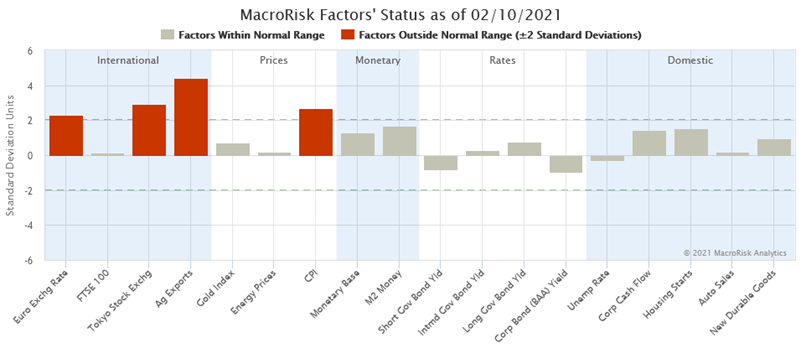The stock market seems to be on a tear lately, a great contrast to about a year ago when the markets started to get roiled by Covid-19 developments. This post uses the patented research on the MacroRisk Analytics® platform to demonstrate the economic climate for the Nasdaq-100 (NDX) stocks as of February 10, 2021 . This information may assist financial advisors and investors in navigating the current economic environment.
To demonstrate this, we use MacroRisk’s economic climate rating (ECR). This robust rating measures the expected impact of the current economic climate for individual assets (including stocks, funds, and many others) over the next six to 12 months. The ECR is a five-star scale where one indicates substantial economic storms in the forecast, and five indicates positive tailwinds with a favorable climate. A three ECR indicates a neutral economy.
As of February 10, 2021, the average ECR is 3.5. This rating means that investors can expect the economic climate to be neutral to favorable for the Nasdaq-100 stocks, on average.

Also, the distribution of ECR looks positive. The graph below shows that there are more Nasdaq-100 stocks for which the economic climate will most likely be favorable (e.g., ratings of four and five) than those stocks for which the climate is expected to be not favorable (e.g., rating of one and two). As of February 10, 2021, there are no stocks in the Nasdaq-100 Index for which the economy is expected to be very unsuitable (e.g., rating of one).

The MacroRisk Analytics model uses 18 macroeconomic factors to determine a stock’s sensitivities to changes in the economy. The ECR combines the economic sensitivities of a stock to the economy with what is actually happening in the economy to determine if the economy is expected to be suitable, not suitable, or neutral for the particular stock.
To illustrate what is currently happening in the economy, we will use the MacroRisk Analytics platform to give us an overview of the state of the economy as of February 10, 2021.

The bars in the graph above indicate where the particular economic factor is relative to its recent moving average. If the bar is above zero, this means that the factor is trending up relative to its recent average and vice versa. The bars highlighted in red bring our attention to the factors most worth paying attention to as they are potentially exhibiting strong, non-random movements. As of February 10, 2021, international factors such as the dollar/euro exchange rate, Tokyo stock exchange, and U.S. agricultural exports are three critical factors. A fourth important factor is the domestic U.S. inflation (i.e., CPI).
Finally, below are ten stocks out of the Nasdaq-100 Index (NDX) that are proposed to be at least somewhat suitable in the current economy (i.e., ECR of four or higher) and that have the highest up-market beta relative to NDX meaning that these stocks tend to go up more than NDX when NDX goes up. The chart shows the data as of February 10, 2021.

The ECR has changed drastically from about a year ago when the ECR was stormy for most Nasdaq stocks. The above data show the economic outlook is expected to be much improved for most Nasdaq-100 stocks. Also, it seems that international factors and U.S. inflation are of more importance now as they exhibit the biggest changes relative to their recent averages. Finally, this post provides a list of ten Nasdaq-100 stocks with an ECR of four or five stars, with the highest up-market beta relative to NDX.
This post is possible thanks to MacroRisk Analytics®. This platform provides investment research for 30,000+ individual names as well as investor portfolios. The MacroRisk Analytics® model uses 18 macroeconomic factors to break down the economy’s impact on investment value. Using this patented research, our team has twice won the William F. Sharpe Indexing Achievement Award for ETF/Indexing Paper of the Year. Click here to access this award-winning investment research today! You can find our other blog posts by clicking here.
Edited by Rania Sullivan.
